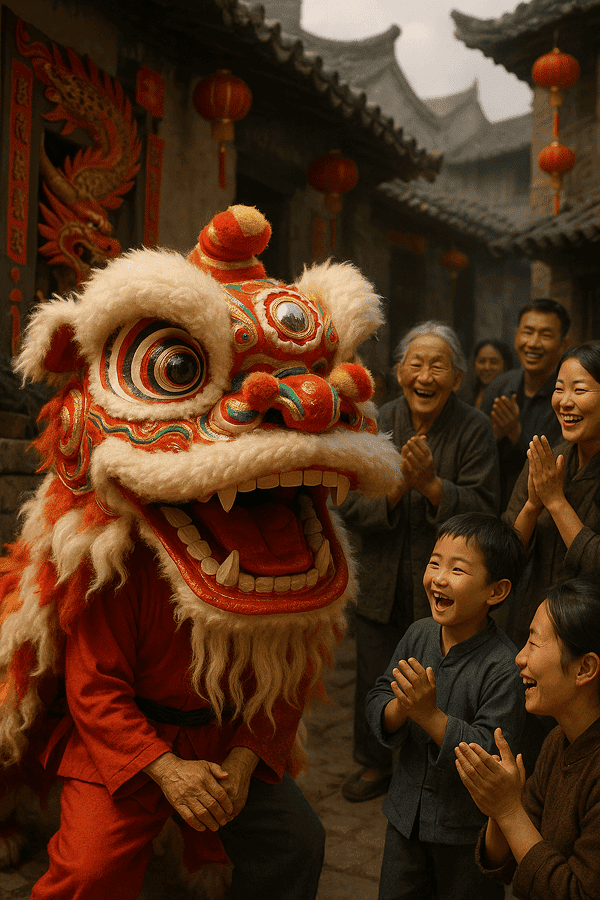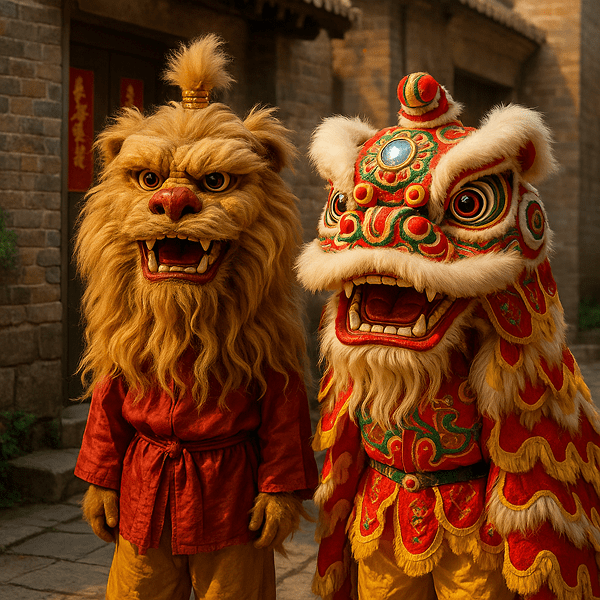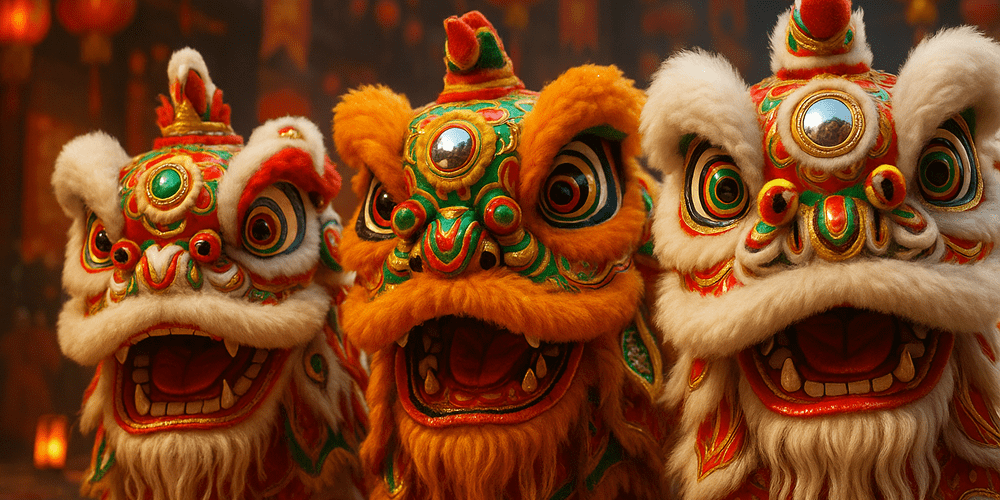Lion Dance Masks are among the most spectacular and recognizable elements of Chinese festive culture. These masks, which are actually large, meticulously crafted lion heads, form the centerpiece of the famous lion dance performances seen during Chinese New Year, temple fairs, business openings, and other celebrations. The Lion Dance Mask is instantly identifiable by its oversized, animated head, expressive eyes, movable mouth, and vibrant colors ranging from red and gold to green and white. Often adorned with fur, mirrors, bells, and elaborate ornamentation, the mask embodies both artistic flair and deep symbolism. Lion Dance Masks are a proud part of Chinese intangible heritage, with their use spanning from northern to southern China and dating back more than a thousand years.
Historical Origins of Lion Dance Masks
The history of Lion Dance Masks traces back to the Han Dynasty (206 BCE–220 CE), when the lion dance first appeared as an imperial court entertainment and a ritual to drive away evil spirits. The term “shi mian” (狮面) literally means “lion face” in Chinese, referencing the mask’s primary purpose: transformation of the dancer into a mythical lion. Early historical texts, such as the “Book of the Later Han,” mention lion dances performed for the emperor. Over time, the mask and dance spread through China and Asia, evolving in design and function in response to changing dynasties, trade routes, and cultural influences. By the Tang and Song dynasties, Lion Dance Masks had become integral to public celebrations and religious ceremonies. Their construction and use continued to develop through the Ming and Qing periods, with regional variations emerging and the dance becoming a symbol of prosperity and protection. Notably, the Spring Festival Masks tradition shares similar roots, as both are linked to new year rituals and the driving away of misfortune.
Cultural Significance and Symbolism of Lion Dance Masks
In Chinese culture, the Lion Dance Mask is a powerful symbol of luck, protection, and community spirit. The lion is not native to China but has long been regarded as a guardian creature, capable of scaring away evil and attracting fortune. During performances, the mask and dance are believed to cleanse spaces of negative energy, bless new ventures, and ensure a prosperous year. The lion’s expressive face, blinking eyes, and open mouth are designed to be both awe-inspiring and approachable, reflecting the dual nature of the lion as a fierce protector and playful companion. Mythologically, the lion dance is linked to stories of villagers scaring off monsters or plagues with the help of a magical beast. Socially, the Lion Dance Mask brings together communities, fosters teamwork among performers, and serves as a living symbol of cultural identity — especially for the Chinese diaspora worldwide.

Materials and Craft Techniques of Lion Dance Masks
Traditional Lion Dance Masks are hand-crafted from materials chosen for their strength, flexibility, and visual effect. The head is usually made from a bamboo or rattan frame, covered in layers of papier-mâché or wire mesh, then painted and decorated with dazzling colors. Artisans use brushes, carving tools, and even their fingers to apply intricate designs, attach fur (often dyed wool or synthetic), and affix mirrors to the forehead — a talisman believed to ward off evil spirits. Eyes and mouth are designed to move, controlled by the lead dancer inside. Regional differences are pronounced: northern lion masks are heavier, with more realistic features, while southern masks (especially Cantonese and Hokkien styles) are lighter, more stylized, and often decorated with sequins, feathers, and elaborate patterns. Color symbolism is central — red for luck, gold for wealth, green for vitality, white for purity, and black for strength. Each mask is a unique work of art, reflecting the heritage and style of the specific troupe or region.
Functions and Uses of Lion Dance Masks
The primary function of Lion Dance Masks is ceremonial and performative. They are worn during the lion dance, which takes place at Lunar New Year, weddings, business openings, temple fairs, and important anniversaries. The mask enables dancers to perform acrobatic feats, mimic the behavior of a lion, and interact with the audience. Theatrically, the mask transforms the dancer into an otherworldly creature, blurring the line between human and spirit. In addition to their role in festivals, Lion Dance Masks are used in religious rituals to bless temples, drive away evil, and invoke good harvests. Over time, their use has expanded to modern events, international competitions, and cultural exchanges. Today, Lion Dance Masks are also featured in parades, film, television, and contemporary art, adapting to new contexts while retaining their ritual power.
Regional Variations of Lion Dance Masks
There are two main regional styles of Lion Dance Masks in China: the Northern Lion and the Southern Lion. The Northern Lion, often seen in Beijing and northern provinces, has a shaggy mane, a realistic face, and is typically performed in pairs (male and female). Its mask is heavier, with a focus on strength and wrestling movements. The Southern Lion, especially popular in Guangdong, Guangxi, and Fujian, features a more stylized head with a pronounced mouth and eyes, vibrant color patterns, and elaborate ornamentation. The Southern Lion’s mask is lighter, allowing for agile dance and acrobatics. Within the southern tradition, further variations exist — such as the Hakka, Fuzhou, and Hok San styles — each with unique mask shapes, decorations, and performance techniques. Compared to similar traditions in Vietnam, Korea, or Japan, Chinese Lion Dance Masks are distinguished by their scale, expressiveness, and cultural symbolism.

Famous Examples and Collections of Lion Dance Masks
Some of the most renowned Lion Dance Masks are preserved in Chinese folk art museums, private collections, and cultural heritage institutions. The Guangdong Folk Arts Museum and the China National Museum of Ethnology showcase historic and contemporary lion heads, including rare examples from the Qing dynasty. Special exhibitions during the Lunar New Year often display antique and modern masks from famous troupes. In addition, private collectors and master artisans across southern China have amassed impressive collections, some of which are featured in documentaries and online galleries such as toddmasks.com. Notable historical finds include century-old lion heads used in imperial ceremonies, as well as regional masterpieces that influenced the evolution of the art form.
Influence of Lion Dance Masks on Art and Culture
Lion Dance Masks have had a profound impact on Chinese visual, performing, and popular arts. Their bold forms and vibrant colors have inspired painters, sculptors, designers, and filmmakers. In literature and cinema, the image of the lion dance evokes themes of community, heroism, and the triumph of good over evil. Lion dance and its masks are frequently featured in Chinese festivals, martial arts demonstrations, and international cultural events, serving as powerful ambassadors of Chinese heritage. Contemporary artists reinterpret lion mask motifs in fashion, graphic design, and installation art, blending tradition with innovation. The ongoing presence of Lion Dance Masks in cultural celebrations helps preserve intangible heritage and foster a sense of pride among younger generations.
Contemporary Status and Preservation of Lion Dance Mask Traditions
Today, the tradition of Lion Dance Mask making and performance remains vibrant, with master artisans, cultural organizations, and dance troupes dedicated to its preservation. Workshops and apprenticeships ensure the transmission of techniques, while museums and cultural centers offer exhibitions and educational programs. The art form has adapted to modern life, with innovations in materials, lighting, and choreography, as well as international collaborations and competitions. Online resources like toddmasks.com play a vital role in connecting artists, scholars, and fans, providing digital access to the history and artistry of Lion Dance Masks. Educational programs and masterclasses are increasingly popular, introducing new generations to the craft and performance of lion dance.
Collecting and Acquiring Lion Dance Masks
The market for Lion Dance Masks ranges from affordable contemporary examples to valuable antiques. Authentic masks can be purchased from artisan studios, folk art markets, galleries, and specialized online platforms. Prices depend on factors such as age, craftsmanship, provenance, and artistic value. Collectors should seek expert advice, verify authenticity, and support ethical sources that benefit the artisan and cultural community. High-quality replicas are popular among enthusiasts, educators, and performers. Toddmasks.com offers guidance on identifying genuine Lion Dance Masks, understanding their cultural significance, and practicing responsible collecting.
